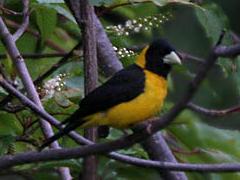Gold grouse
| Gold grouse | ||||||||||||
|---|---|---|---|---|---|---|---|---|---|---|---|---|

Gold grouse, male |
||||||||||||
| Systematics | ||||||||||||
|
||||||||||||
| Scientific name | ||||||||||||
| Mycerobas icterioides | ||||||||||||
| ( Vigors , 1831) |
The gold grouse ( Mycerobas icterioides ) is a species from the goldfinch family . The species occurs exclusively in Asia. The IUCN classifies the species as ![]() (= least concern - not endangered).
(= least concern - not endangered).
Appearance
The gold grouse reaches a body length of 23 centimeters. There is a gender dimorphism . The females of the gold grouse are much more inconspicuous in color. The males of the golden grosbeak, on the other hand, are very similar to the males of the yellow-thigh grosbeak . However, the black parts of the plumage are smaller in golden grosbeak. The difference is particularly noticeable on the head.
The male has a black head, a black chin and a black throat. The wings and tail are also black. The rest of the body plumage is bright yellow, which has led to the German name Goldkernbeißer. The females are less contrasty in color. With them, the head and the rest of the top of the body are dark gray. On the rump and on the upper tail-coverts , the plumage turns into a reddish brown. The wings and tail feathers are black as in the male. The belly and the underside of the tail are light brown, the breast is gray-brown. The eyes are brown in both sexes.
Way of life
The distribution area of the gold grouse stretches from the northeast of Afghanistan over the north of Pakistan and India to Tibet . The gold grouse is a bird of high altitude. During the summer he stays at altitudes between 2500 and 3000 meters. During the winter time he seeks lower areas. Outside of the breeding season, it can usually be found in small schools. He often looks for food on the ground. The food spectrum includes shoots of conifers and seeds of various plants.
The nest is cup-shaped and is usually built six to twenty meters above the ground. The clutch comprises two to three eggs.
Keeping in human care
Goldhorns were first shown at London Zoo in 1885 . They are occasionally imported to this day. Nothing is known of breeding in European keeping. It may play a role here that in the few imports the proportion of contrasting colored males clearly exceeds the proportion of less attractive colored females.
supporting documents
Individual evidence
- ↑ BirdLife Factsheet , accessed July 16, 2009
- ↑ a b Bielfeld, p. 78.
- ↑ Bielfeld, p. 79
literature
- Horst Bielfeld : siskins, giraffe, bullfinches and grosbeak. Verlag Eugen Ulmer, Stuttgart 2003, ISBN 3-8001-3675-9 .
Web links
- Mycerobas icterioides inthe IUCN 2013 Red List of Endangered Species . Listed by: BirdLife International, 2012. Retrieved January 3, 2014.
